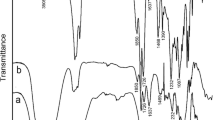Abstract
Cellulose was dissolved in lithium chloride/1,3-dimethyl-2-imidazolidinone (LiCl/DMI), and reacted with alkylketene dimers (AKDs) under non-aqueous and homogeneous conditions to prepare cellulose/AKD β-ketoesters with high degrees of substitution (DS). Six AKDs synthesized from octanoic, decanoic, dodecanoic, tetradecanoic, hexadecanoic and octadecanoic acids via their fatty acid chlorides were used in this study. The cellulose/AKD β-ketoesters obtained were gummy solid at room temperature, and had DS values ranging from 1.9 to 2.9. Cellulose/fatty acid esters with DS 2.5–2.9 were also prepared as references. 13C-NMR spectra of the cellulose/AKD β-ketoesters showed that cellulose carbons and substituent carbons close to cellulose chains were restricted in motion and behaved like solid in solutions. In contrast, the cellulose/fatty acid esters did not demonstrate such anomalous 13C-NMR spectra. The unique 13C-NMR patterns are characteristic for the cellulose/AKD β-ketoesters, which have long and branched alkyl substituents in each anhydroglucose unit. Size-exclusion chromatography furnished with multi-angle laser light scattering (SEC-MALLS) revealed, on the other hand, that all cellulose/AKD β-ketoesters and cellulose/fatty acid esters prepared had flexible or random-coil conformations in tetrahydrofuran (THF). There were no clear differences in conformation or stiffness of cellulose chains between cellulose/AKD β-ketoesters and cellulose/fatty acid esters.






Similar content being viewed by others
References
Benoit H, Doty P (1954) Light scattering from non-Gaussian chains. J Phys Chem 57:958–963
Clemens RJ (1986) Diketene. Chem Rev 86:241–318
Edger KJ, Arnold KM, Blount WW, Lawniczak JE, Lowman DW (1995) Synthesis and properties of cellulose acetoacetate. Macromolecules 28:4122–4128
Edgar KJ, Pecorini TJ, Glasser WG (1998) Long-chain cellulose esters: preparation, properties, and perspective. ACS Symp Ser 688:38–60
Isogai A, Ishizu A, Nakano J (1986) Preparation of tri-O-alkylcelluloses by the use of a non-aqueous cellulose solvent and their physical characteristics. J Appl Polym Sci 31:341–452
Isogai A (2000) Stability of AKD-cellulose β-ketoester bonds to various treatment. J Pulp Pap Sci 26:330–334
Ito T, Tsujii Y, Suzuki H, Fukuda T, Miyamoto T (1992) Monolayer and multilayer Langmuir-Blodgett films of cellulose tri-n-alkyl esters studied by transmission electron microscopy. Polym J 24:641–652
McCormick CL (1981) A new cellulose solvent for preparing derivatives under homogeneous conditions. US Patent 4, 278, 790
Potthast A, Rosenau T, Sixta H, Kosma P (2002) Degradation of cellulosic materials by heating in DMAc/LiCl. Tetrahedron Lett 43:7757–7759
Sealey JE, Samaranayake G, Todd JG, Glasser WG (1996) Novel cellulose derivatives. 4. Preparation and thermal analysis of waxy esters of cellulose. J Polym Sci Polym Phys 34:1613–1620
Takaragi A, Minoda M, Miyamoto T, Liu HQ, Zhang LN (1999) Reaction characteristics of cellulose in the LiCl/1,3-dimethyl-2-imidazolidinone solvent system. Cellulose 6:93–102
Tujii Y, Ito T, Fukuda T, Miyamoto T, Ito S, Yamamoto M (1992) Multilayer films of chromophoric cellulose octadecanoates studied by fluorescence spectroscopy. Langmuir 8:936–941
Turbak AF, EL-Katrawy A, Synder FW, Auerbach AB (1980) Solvent system for cellulose. US Patent 4, 302, 252
Wenzel M, Burchard W, Schätzel K (1986) Dynamic light-scattering from semidilute cellulose-tricarbanilate solutions. Polymer 27:195–201
Yanagisawa M, Isogai A (2005) SEC-MALLS-QELS study on the molecular conformation of cellulose in LiCl/amide solutions. Biomacromolecules 6:1258–1265
Yoshida Y, Yanagisawa M, Isogai A, Suguri N, Sumikawa N (2005) Preparation of polymer brush-type cellulose β-ketoesters using LiCl/1,3-dimethyl-2-imidazolidinone as a solvent. Polymer 46:2548–2557
Witzeman JS, Nottingham WD (1991) Transacetoacetylation with tert-butyl acetoacetate: synthetic applications. J Org Chem 56:1713–1718
Acknowledgement
This research was supported by a Grand-in-Aid for Scientific Research (Grant number 15658052) from the Japan Society for the Promotion of Science (JSPS). Mr. Kazumichi Asakura of NOF Corporation, Japan, kindly provided alkylketene dimers. We thank Mr. Masahide Nakamura of Shoko Co. Ltd., Japan, for arranging the dn/dc measurements.
Author information
Authors and Affiliations
Corresponding author
Rights and permissions
About this article
Cite this article
Yoshida, Y., Isogai, A. Preparation and characterization of cellulose β-ketoesters prepared by homogeneous reaction with alkylketene dimers: comparison with cellulose/fatty acid esters. Cellulose 14, 481–488 (2007). https://doi.org/10.1007/s10570-007-9133-0
Received:
Accepted:
Published:
Issue Date:
DOI: https://doi.org/10.1007/s10570-007-9133-0




